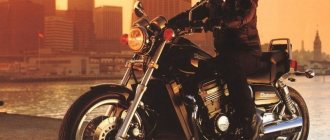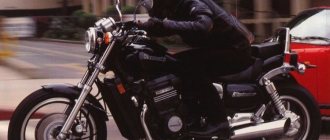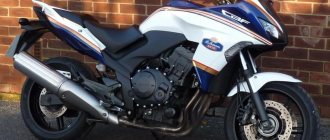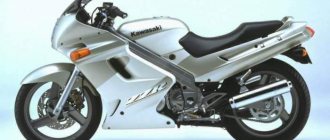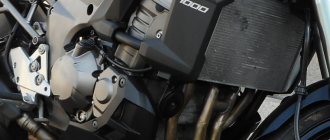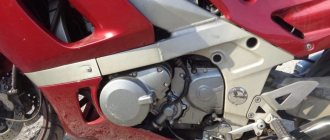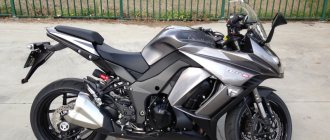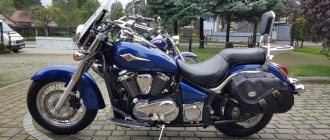Kawasaki ZL 1000 Eliminator - This is one of the few motorcycles that was produced for only one year. It is very similar to the ZL 900, but it has increased in size. This is a long, tall, large motorcycle that is suitable for leisurely riding along the endless expanses of asphalt highways.
A cruiser in its essence, it does not shine with exorbitant power. However, like all representatives of the Eliminator series, it has some similarities with sports bikes. A motorcycle will not be a good choice for those who are just starting to master two-wheeled transport, but some experienced drivers will like it. Like all “mixes”, this cross between classics and sports finds a response in the hearts of only a small audience. Such stories are too specific.
Engine
The machine is equipped with an in-line four-cylinder engine. It is liquid cooled and has a fairly large displacement: 997 cubic centimeters. The maximum power of this product is 110 horsepower and is achieved at 9000 rpm. The motorcycle's peak torque is 91 Newton meters, and it is achieved at 7000 rpm.
The maximum speed is impressive, amounting to 211 kilometers per hour. For such an impressively sized bike, this is a serious indicator. This is also why this car is not the best choice for beginners. In addition, driving such a machine, although relatively maneuverable, is not so easy, especially at high speeds. This requires experience, which is better to get on other motorcycles, where it is probably clear what to expect from the machine.
Specifications
Technical characteristics of Kawasaki ZL1000 Eliminator:
| Model | Kawasaki ZL1000 Eliminator |
| Motorcycle type | power cruiser (dragster) |
| Year of issue | 1987-1988 |
| Frame | steel duplex |
| engine's type | 4-cylinder, 4-stroke, in-line |
| Working volume | 997 cm³ |
| Bore/Stroke | 74.0 x 58.0 mm |
| Compression ratio | 10.2:1 |
| Cooling | liquid |
| Number of valves per cylinder | DOHC, 4 valves per cylinder |
| Fuel supply system | Carburetor, 4x Keihin CVK34 |
| Ignition type | transistor |
| Maximum power | 110.0 hp (80.9 kW) at 9000 rpm |
| Maximum torque | 91.2 Nm (9.3 kg*m) at 7000 rpm |
| Clutch | Multi-disc in oil bath, hydraulic drive |
| Transmission | 6-speed |
| type of drive | cardan |
| Front tire size | 100/90-18 (56H) |
| Rear tire size | 160/80-15 (74H) |
| Front brakes | 2 discs, 277 mm, 1-piston calipers |
| Rear brakes | 1 disc, 267 mm, 1-piston caliper |
| Front suspension | Telescopic fork 38 mm (pneumatic), travel - 150 mm |
| Rear suspension | pendulum with two shock absorbers (pneumatic, 4-stage rebound adjustment), stroke - 110 mm |
| Motorcycle length | 2305 mm |
| Motorcycle width | 790 mm |
| Motorcycle height | 1150 mm |
| Wheelbase | 1615 mm |
| Seat height | 750 mm |
| Minimum ground clearance (clearance) | 155 mm |
| Acceleration 0-100 km/h (0-60 mph) | 4.0 sec[1] |
| Maximum speed | 211 km/h |
| Gas tank capacity | 18.5 l (including reserve - 2.0 l) |
| Motorcycle weight (dry) | 243 kg |
| Motorcycle weight (curb) | 270 kg |
Dimensions and weight
In terms of its dimensions, the motorcycle is considered large. It reaches 2305 millimeters in length, which is quite a lot. The width of the bike is 790 millimeters, and the height is 1150 millimeters. The saddle height of the motorcycle reaches 750 millimeters. The weight of the motorcycle is impressive and is 270 kilograms including fuel, and 244 kilograms without fuel. Its wheelbase is 1615 millimeters.
Review of the Kawasaki EL 250 Eliminator motorcycle
The motorcycle is quite old (1988), but after 2 seasons, I can say that it will live for a very long time, because during the entire time I owned it I had no problems, I bought it second-hand and very spontaneously, the budget was around 70 000, of course, like all beginners, I looked at bandits and seabirds, but they were very expensive and an eliminator turned up for me, I went with a friend to look, we arrived, it was clear that the motorcycle was well-maintained, there were shoals on the tank in the form of scratches and dents, but they I wasn’t too worried, it started right away, I was happy about it, it worked quietly and smoothly, I walked around and looked, well, I think I’ll go for a ride, I sit down, the seating position is very comfortable, since the motorcycle is low and the handlebars with the stem are very conveniently located in front of you, I start to move off, I let go a little clutch and... off I went, I was very surprised that getting started on this motorcycle is easier than on a bicycle, I rode a little, I was pleased with the soft suspension and the smooth ride of the motorcycle, I went home, so to speak, to think, the next time I bought it) First trip, I'm getting underway also elementary, I get out on the road and start accelerating, the acceleration for a 250 cc in-line 2-cylinder engine is very good, there are no obvious failures, starting from 2 thousand the engine turns decently until the 13 thousand mark, the brakes are good, especially the front disc, acceleration from a standstill better than classmates such as the bandit, but on the highway after 120 km it loses in dynamics, the sound is quiet, the landing is comfortable, in general I was in seventh heaven, later I went with friends on a mini-long trip)) from Krasnodar to Goryachy Klyuch, to I rode confidently on the highway, the motorcycle did not show any flaws, we rode successfully there and back, around the city, probably one of the most comfortable motorcycles, small, nimble, with excellent handling and low fuel consumption. To sum up, I can say that the motorcycle, despite for its age, it has never let me down, it is very comfortable and has a good, unpretentious engine that allows you to start from traffic lights on par with some 400s. I would recommend it as a first motorcycle to all beginners. Thank you for your attention, good luck on the roads, buy elims))
The motor is very light in weight and is therefore highly susceptible to shifting by the wind.
The rear shocks need to be adjusted to suit the specific driver due to the fact that when the springs are retightened, they begin to wobble very strongly on the longitudinal cracks.
in small radius turns it bends towards the inside of the turn.
insufficient braking dynamics when using only the front brake. at low speeds (up to 60 km/h) it is quite enough, but then you have to use the rear very sharp drum to reduce the braking distance.
during active driving there is a very immodest appetite for 95th gasoline (up to 8 liters per 100 km).
It is very inconvenient to maintain the chain due to the lack of a central stand.
In sunny weather, the indicator lights are difficult to read (my copy does not have a bikini fairing).
possible lack of downshifts. The box is loud and clear.
to replace spark plugs you have to remove the tank and ignition coils... you need a spark plug of medium length (mine is 12cm) with thin walls.
carbs are subject to frequent desynchronization (why).
when replacing the fork seals, I swore for a long time due to the fact that the plugs of the stays are installed on locking springs, which even with the help of a friend could not be removed, as a result, it was not possible to wash the giblets of the front shock absorbers... when unscrewing the bolts holding the giblets, you need to be careful and use untortured hexagons as the bolts are susceptible to breaking splines. Oil filling was done through the oil drain holes. When filling engine oil with a viscosity of SAE 20, the dive when braking decreased noticeably.
When changing engine oil, it would be good to use flushing fluid and not a 5-minute additive, since due to the design of the oil pan, a fairly decent amount of old oil remains, 100-150g out of 1.9 liters provided when filling with an oil filter change. It is advisable to remember that the moto is on its side and not to pour immediately to the maximum level, otherwise it will overflow (I forgot and then had to drain it).
but all shortcomings are compensated by serious acceleration in all 6 gears. cruising speed 120 km/h I managed to push mine to 160 maximum speed ((: drive in control in dynamic shots from traffic light to traffic light and unsharp maneuvering in traffic..
I’ve been driving the EL 250 for three years now, and I want to share my impressions. Rear brake - full. It either doesn’t slow down or immediately blocks; I use it very rarely. The front one is of course better, but still rather weak, but it can be helped by the engine - when I release the throttle, the bike itself slows down quite intensively. When braking sharply, there is a dive, but I'm already used to it. About the fork seals: when I bought the bike from the previous owner, he told me that he did not buy original ones, but picked up seals from Toyota that were similar in diameter at an auto parts store. They turned out to be a little larger, so he somehow expanded the seat and stuck them there. Toyota ones are much cheaper, and they are easier to get, at least in Novosibirsk. In three years of operation I have never changed them, there was no need. There are no complaints about the rear shock absorbers. The box works clearly, both up and down, the only drawback is that it is very loud. Replacing the air filter and spark plugs caused problems only the first time, then I easily remembered the algorithm for removing the seat and tank. The engine, despite its modest size, is quite strong enough to be the first to leave a traffic light. Comfortable speed is 100 - 120. The maximum speed was 140 km/h, at 11,500. The red zone on the tachometer starts at 14,000, so there is still some reserve. I just don’t want to go faster. It blows away!!! And yet he’s light, he’s trying to fly, damn it! This is where some of our smaller brothers (motorists) overtake! It's a shame! I never measured my consumption, but if I ate a lot I would have noticed. Although the fuel level would not be a problem, sometimes you forget and go far, and on the way back you think - will it be enough or not? The oil level has not dropped a millimeter over the season. Regarding the instruments: there are no complaints about the speedometer and tachometer, but the indicator lights are not visible in sunny weather. But at night everything looks very beautiful, because... The backlight is like on a BMW, red. I have a straight steering wheel, there are no problems with turning on the spot and when maneuvering in motion, everything is very comfortable, my arms and back do not get tired even if I have to drive very far. Of course, there is a tendency towards blockages, but if you keep the situation under control, then everything will be ok. Another positive point is the direct flow inherited from the old owner. The twin sounds especially beautiful at low end. But for some reason the neighbors don't like it. This season I bought plastic luggage cases. For a long time I doubted whether to install them or not, but when I did, all doubts immediately disappeared. This added solidity to the motorcycle, it is now just like an adult. Yes, I also really don’t like this aspect: the front fender is a bit short and therefore half of the radiator is always clogged with dirt. There have never been any overheats, but constantly cleaning the radiator is annoying. In general, the motorcycle is incendiary!!!
I rode for two years, it was my first “Japanese bike”, I’m very pleased, the steering wheel is easy and the speeds are switched “clearly”, in the city - good dynamics, though 6 speeds - you constantly click, but the 6th is quite high-torque and pulls out from 50, consumption - 3-4 liters . In the city it’s comfortable, light and narrow, above 110 it’s really uncomfortable..
About the brakes - I changed the pads and repair kit (rubber bands and polished the brake cylinders) on the front, I just rebuilt the rear - it brakes very well, softly and tenaciously.
About the tidy... the lamps are invisible in sunny weather, I changed them to LEDs and it became much better.
I can only leave positive feedback. The pepelats was bought from a Japanese trash heap, apparently it was at the bottom of the heap since the shock absorbers were folded and rusted in this position, compressing the springs. The rear shock absorbers were with expansion chambers, cut, knocked out, and the rods were sharpened from the gas lifts of the Laurel hood. the front fork sagged, after screwing in the nipples and 1-1.5 kg, just a song. It was all bolted down and painted with varnish. I installed a car alarm, horns, compressor, and receiver. I ran through everything quickly. I accelerated to 180 as much as possible, although the wind was tailwind and lay behind the visor. An excellent motorcycle for those who like to drive hard. It’s fast enough to accelerate to hundreds, but after 140 it’s already a bit difficult, and with a passenger it’s much earlier. consumption is 6-8, but if you wish you can go to 10. doesn't eat butter. I’m now collecting dust in the garage for the second season, maybe I’ll sell it, but I don’t know for how much….
I acquired this motor shortly before the end of the season. I chose for a long time (due to the lack of coins), I didn’t look at anything (initially there was a criterion: no less than 400), I looked at a cactus for 50 k, well, it was in a very tired state (the tank is rusty, the plastic in the bikini area is on snot and wire, the carbs were not reset below 4000 rpm. Well, I completely gave up. After the technician, the next day I stopped by Industrialnaya to do nonsense, look at the spendthrifts, wandering through the rows of Oleg’s, I thought: To hell with scabies, chick also rolled, climbed into the core, I see Elim costs 250 se. Well, after consulting with my friend Palladin - the noble Elimovod, I called the seller, agreeing on a viewing for the evening. We met at Komsa, examined the Elim (after the sensations about the cactus, I was very pleased, mot was polished, without any defects on the exterior, the tires were in excellent condition. Well, I took it for a ride. The motor showed its best side: good dynamics, comfortable fit (my height: 187 cm), pleasant twin sound (especially at the bottom) and in general I was satisfied. Returning to the seller, I agreed to purchase. The next day: re-registration, registration and the way home, wash)). In general, I managed to drive it before the wild frosts and snow: 1700 km. Yes, this is not a sufficient mileage, but even after the car got used to the acceleration and 155 km/h was no longer enough, I don’t regret the purchase at all. (speed is not happiness). In general: Cool lighter) but the check is modest, but if you need a moto to quench motor toxicosis or leisurely rides around the neighborhood or city, then this option is really good)
My first motorcycle. When I was planning to start, I didn’t have any particular preferences - I was looking for something I liked for the money I had (70 rubles). When I came across it, I fell in love from the first photo. Looks just awesome :). The motorcycle is very light - only 140 kg. Markings on the speedometer up to 160 km/h. I personally accelerated to 140 with a passenger. An excellent option for beginners, as it is light weight and easy to operate. It pulls two people, but you can already feel the passenger, especially if you’re not carrying a girl. Also, when driving with two people, the rear suspension breaks. The brakes are excellent: very grippy and predictable. A couple of times, out of fright, I skidded off the rear wheel, but everything worked out :) The motorcycle also has pretty decent dynamics at speeds of up to 100 km/h, although I haven’t measured the acceleration yet, but I’m not far behind my friend on a Yamaha Virago 1100. This also makes it difficult to drive calmly at times :).
Consumption per hundred from 3.5 liters. On the highway, with quiet driving at 100 km/h. That's how it works. In the city, especially if you burn it out, consumption can easily reach 10 liters, which, with a small tank (13 liters), is a frequent reason for visits to gas stations :)
Due to the unique design of the exhaust, it is difficult to maintain. If you get into the carburetors or engine, it must be removed.
I really like the motorcycle, I plan to finish this season. In the future, I wouldn’t mind staying at the older lums.
